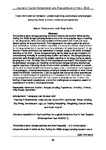From liminoid to limivoid: Understanding contemporary bungee jumping from a cross-cultural perspective
| dc.contributor.author | Thomassen, B. | |
| dc.contributor.author | Balle, M. | |
| dc.date.accessioned | 2018-05-18T11:20:38Z | |
| dc.date.accessioned | 2018-05-24T12:48:11Z | |
| dc.date.available | 2018-05-18T11:20:38Z | |
| dc.date.available | 2018-05-24T12:48:11Z | |
| dc.date.issued | 2012 | |
| dc.identifier.citation |
Thomassen, B. and Balle, M. (2012) 'From liminoid to limivoid: Understanding contemporary bungee jumping from a cross-cultural perspective', Journal of Tourism Consumption and Practice, 4(1), p.59-93 | |
| dc.identifier.issn | 1757-031X | |
| dc.identifier.uri | http://hdl.handle.net/10026.1/11586 | |
| dc.description.abstract |
This article is about bungee jumping and how it reflects the world in which we live. During the 1980s bungee jumping became one of the most popular ways of seeking a ‘real experience’, when the practice was commercialised and introduced as a leisure activity all around the world. This happened in the same period as outdoor sport activities or ‘outdoor recreation’ exploded in kinds and numbers, clearly linked to the ‘experiential turn in tourism’ and the proliferation of ‘adventure tourism’. A key feature of these activities is the experience of danger: going to the limits, or indeed, standing on the limit. Hence, bungee jumping can be seen as an apt metaphor for understanding liminality in contemporary tourism and leisure. The bungee jumping adventure quite literally positions the subject standing on an edge, facing an abyss, jumping into a void. But what kind of limit experiences are these? This question can be addressed, we argue, by matching contemporary bungee jumping experiences against practices of jumping rituals in non-modern societies, which seem to contain some common features with the modern bungee jump. In contrast to more ‘classical’ ritual passages, contemporary bungee jumping is clearly an example of what Turner called the liminoid. Furthermore, it can be argued that insofar as these experiences involve no transformation of subjectivity or no passage to the ‘other world’, bungee jumping signifies a further shift from the liminoid to what we call the ‘limivoid’: the inciting of near-death experiences, a jump into nothingness, a desperate search for experience in a world of ontological excess. | |
| dc.language.iso | en | en_US |
| dc.publisher | University of Plymouth | |
| dc.subject | Adventure Tourism | |
| dc.subject | Bungee Jumping | |
| dc.subject | Experience | |
| dc.subject | Liminality | |
| dc.subject | Liminoid | |
| dc.subject | Pole Rituals | |
| dc.subject | Symbolism | |
| dc.title | From liminoid to limivoid: Understanding contemporary bungee jumping from a cross-cultural perspective | en_US |
| dc.type | Article | |
| plymouth.issue | 1 | |
| plymouth.volume | 4 | |
| plymouth.journal | Journal of Tourism Consumption and Practice |


